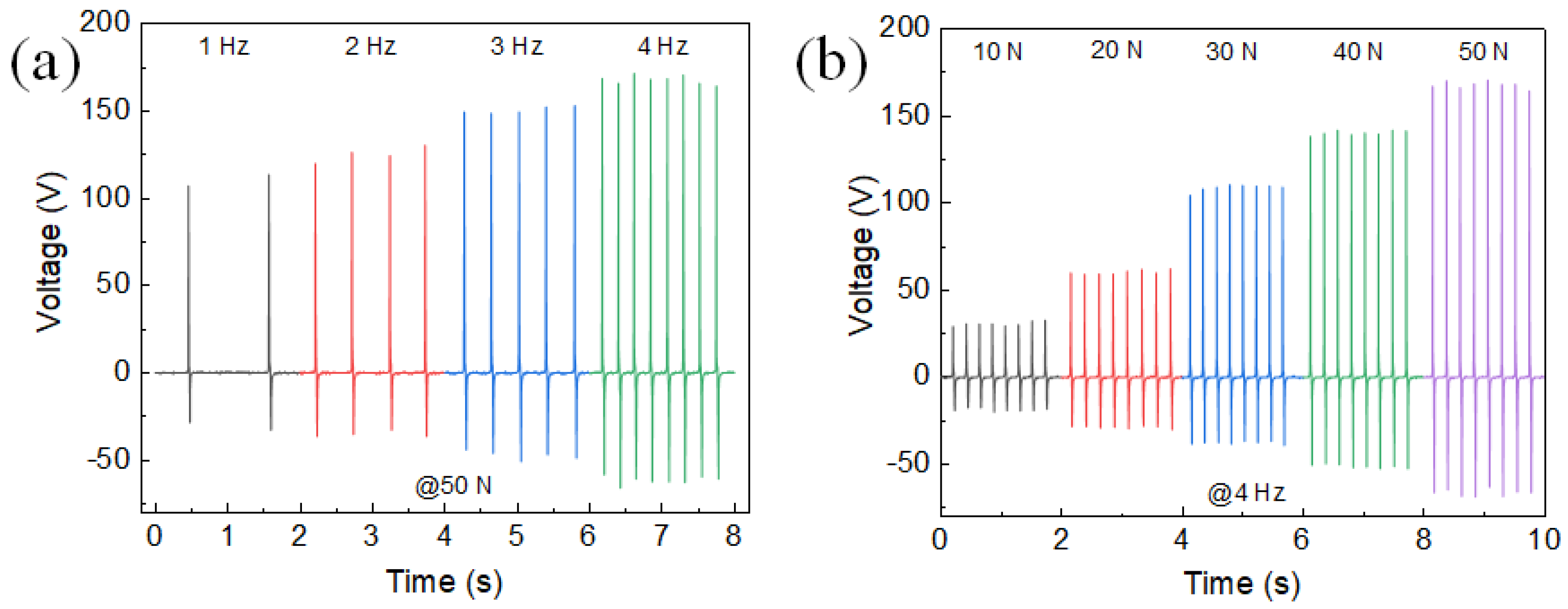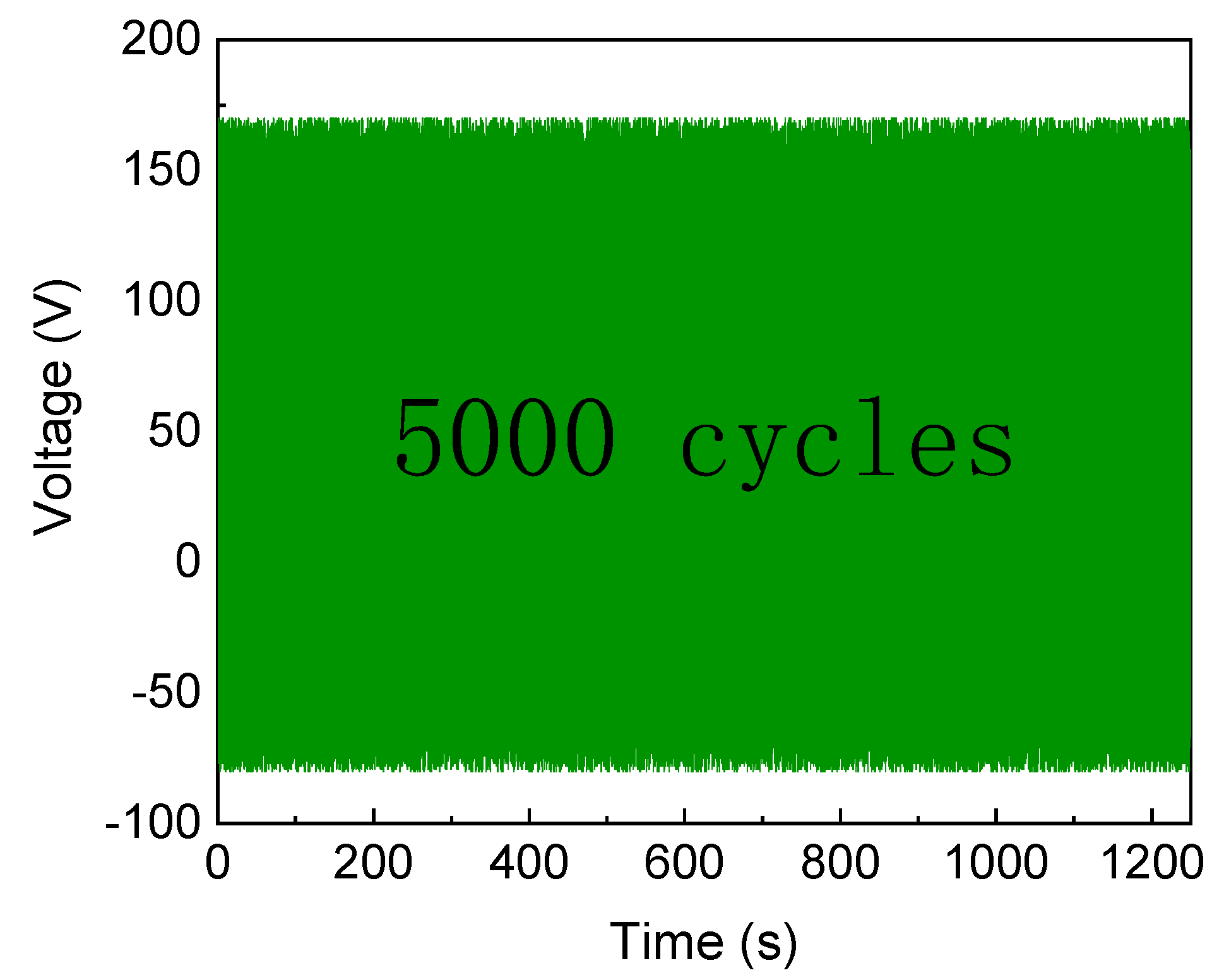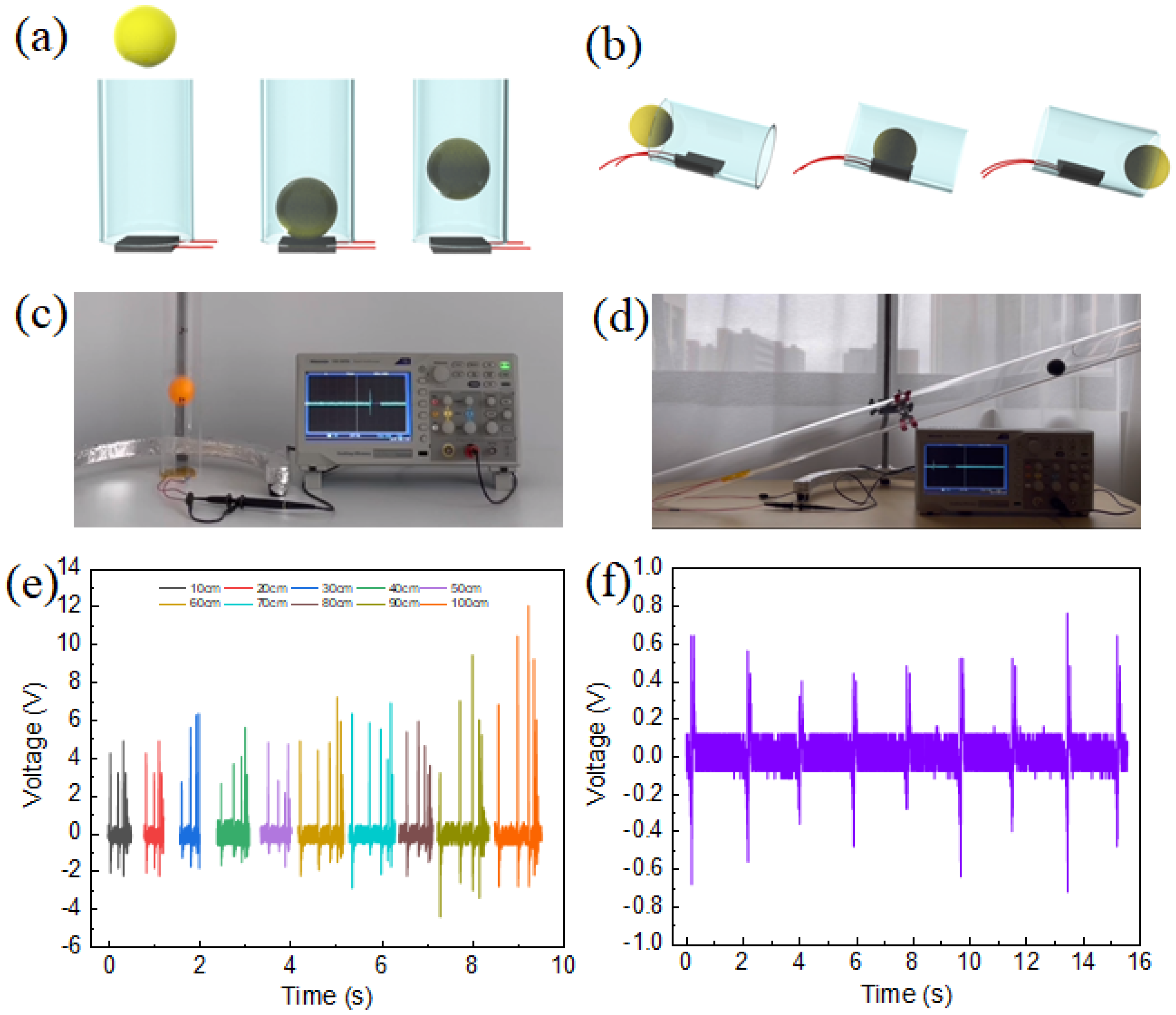Coral-like BaTiO3-Filled Polymeric Composites as Piezoelectric Nanogenerators for Movement Sensing
Abstract
1. Introduction
2. Materials and Methods
2.1. Preparation of the Coral-like BaTiO3
2.2. Preparation of the PVDF/Coral-like BaTiO3 Film and PENG
2.3. Characterization and Electric Measurement
2.4. Simulation
3. Results
4. Conclusions
Supplementary Materials
Author Contributions
Funding
Institutional Review Board Statement
Data Availability Statement
Conflicts of Interest
References
- Guo, R.; Zhang, H.; Cao, S.; Cui, X.; Yan, Z.; Sang, S. Design, A self-powered stretchable sensor fabricated by serpentine PVDF film for multiple dynamic monitoring. Mater. Des. 2019, 182, 108025. [Google Scholar] [CrossRef]
- Liu, S.; Wu, X.; Kong, Y.; Peng, X. Measurement method for fluid pressure fluctuation in fluid-conveying pipe using PVDF piezoelectric film sensor. Appl. Sci. 2021, 11, 1299. [Google Scholar] [CrossRef]
- Chen, J.; Zhao, J.; Lin, L.; Sun, X. Truncated conical PVDF film transducer for air ultrasound. IEEE Sens. J. 2019, 19, 8618–8625. [Google Scholar] [CrossRef]
- Hu, D.; Yao, M.; Fan, Y.; Ma, C.; Fan, M.; Liu, M. Strategies to achieve high performance piezoelectric nanogenerators. Nano Energy 2019, 55, 288–304. [Google Scholar] [CrossRef]
- Lee, Y.; Kim, J.; Joo, H.; Raj, M.S.; Ghaffari, R.; Kim, D. Wearable sensing systems with mechanically soft assemblies of nanoscale materials. Adv. Mater. Technol. 2017, 2, 1700053. [Google Scholar] [CrossRef]
- Zhu, J.; Zhou, C.; Zhang, M. Recent progress in flexible tactile sensor systems: From design to application. Soft Sci. 2021, 1, 3. [Google Scholar] [CrossRef]
- Liu, Y.; Pharr, M.; Salvatore, G. A lab-on-skin: A review of flexible and stretchable electronics for wearable health monitoring. Acs Nano 2017, 11, 9614. [Google Scholar] [CrossRef]
- Coskun, M.B.; Akbari, A.; Lai, D.; Neild, A.; Majumder, M.; Alan, T. Interfaces, Ultrasensitive strain sensor produced by direct patterning of liquid crystals of graphene oxide on a flexible substrate. ACS Appl. Mater. Interfaces 2016, 8, 22501. [Google Scholar] [CrossRef]
- Yang, R.; Qin, Y.; Dai, L.; Wang, Z.L. Power generation with laterally packaged piezoelectric fine wires. Nat. Nanotechnol. 2014, 4, 34–39. [Google Scholar] [CrossRef]
- Jian, G.; Meng, Q.; Yang, N.; Feng, L.; Wang, F.; Chen, Y.; Wong, C.-P. Superhigh charge density and direct-current output in triboelectric nanogenerators via peak shifting modified charge pumping. Nano Energy 2022, 102, 107637. [Google Scholar] [CrossRef]
- Xu, Q.; Wen, J.; Qin, Y. Development and outlook of high output piezoelectric nanogenerators. Nano Energy 2021, 86, 106080. [Google Scholar] [CrossRef]
- Karan, S.K.; Maiti, S.; Agrawal, A.K.; Das, A.K.; Maitra, A.; Paria, S.; Bera, A.; Bera, R.; Halder, L.; Mishra, A.K.; et al. Designing high energy conversion efficient bio-inspired vitamin assisted single-structured based self-powered piezoelectric/wind/acoustic multi-energy harvester with remarkable power density. Nano Energy 2019, 59, 169–183. [Google Scholar] [CrossRef]
- Zhang, Y.; Zhou, L.; Liu, C.; Gao, X.; Zhou, Z.; Duan, S.; Deng, Q.; Song, L.; Jiang, H.; Yu, L.; et al. Self-powered pacemaker based on all-in-one flexible piezoelectric nanogenerator. Nano Energy 2022, 99, 107420. [Google Scholar] [CrossRef]
- Jiao, P.; Hasni, H.; Lajnef, N.; Alavi, A.H. Mechanical metamaterial piezoelectric nanogenerator (MM-PENG): Design principle, modeling and performance. Mater. Des. 2019, 187, 108214. [Google Scholar] [CrossRef]
- Bowen, C.R.; Kim, H.A.; Weaver, P.M.; Dunn, S. Piezoelectric and ferroelectric materials and structures for energy harvesting applications. Energy Environ. Sci. 2013, 7, 25–44. [Google Scholar] [CrossRef]
- Falconi, C. Piezoelectric nanotransducers. Nano Energy 2019, 59, 730–744. [Google Scholar] [CrossRef]
- Xie, L.; Wang, G.; Jiang, C.; Yu, F.; Zhao, X. Properties and applications of flexible poly (vinylidene fluoride)-based piezoelectric materials. Crystals 2021, 11, 644. [Google Scholar] [CrossRef]
- Zhao, Y.; Liao, Q.; Zhang, G.; Zhang, Z.; Liang, Q.; Liao, X.; Zhang, Y. High output piezoelectric nanocomposite generators composed of oriented BaTiO3 NPs@PVDF. Nano Energy 2015, 11, 719–727. [Google Scholar] [CrossRef]
- Ghajar, M.H.; Mousavi Mashhadi, M.; Irannejad, M.; Yavuz, M.; Abdel-Rahman, E. Effects of static electricity and fabrication parameters on PVDF film properties. Bull. Mater. Sci. 2018, 41, 43. [Google Scholar] [CrossRef]
- Park, K.I.; Jeong, C.K.; Ryu, J.; Hwang, G.T.; Lee, K.J. Nanocomposites: Flexible and large-area nanocomposite generators based on lead zirconate titanate particles and carbon nanotubes. Adv. Energy Mater. 2013, 3, 1530. [Google Scholar] [CrossRef]
- Baek, C.; Yun, J.H.; Wang, J.E.; Jeong, C.K.; Lee, K.J.; Park, K.I.; Kim, D. A flexible energy harvester based on a lead-free and piezoelectric BCTZ nanoparticle-polymer composite. Nanoscale 2016, 8, 17632–17638. [Google Scholar] [CrossRef]
- Park, K.I.; Jeong, C.K.; Kim, N.K.; Lee, K. Stretchable piezoelectric nanocomposite generator. Nano Conwergence 2016, 3, 12. [Google Scholar] [CrossRef]
- Sultana, A.; Sadhukhan, P.; Alam, M.M.; Das, S.; Middya, T.R.; Mandal, D. Organo-lead halide perovskite induced electroactive beta-phase in porous PVDF films: An excellent material for photoactive piezoelectric energy harvester and photodetector. ACS Appl. Mater. Interfaces 2018, 10, 4121–4130. [Google Scholar] [CrossRef] [PubMed]
- Zhang, C.; Fan, Y.; Li, H.; Li, Y.; Zhang, L.; Cao, S.; Kuang, S.; Zhao, Y.; Chen, A.; Zhu, G.; et al. Fully rollable lead-free poly(vinylidene fluoride)-niobate-based nanogenerator with ultra-flexible nano-network electrodes. ACS Nano 2018, 12, 4803–4811. [Google Scholar] [CrossRef] [PubMed]
- Kang, H.B.; Han, C.S.; Pyun, J.C.; Ryu, W.H.; Kang, C.Y.; Cho, Y.S. (Na,K)NbO3 nanoparticle-embedded piezoelectric nanofiber composites for flexible nanogenerators. Compos. Sci. Technol. 2015, 111, 1–8. [Google Scholar] [CrossRef]
- Guan, Y.; Bai, M.; Wang, Q.; Liu, L.; Yu, S.; Kong, B.; Lv, F.; Guo, M.; Liu, G.; Li, L.; et al. A self-powered wearable piezoelectric nanogenerator for physiological monitoring based on lead zirconate titanate/microfibrillated cellulose@ polyvinyl alcohol (PZT/MFC@ PVA) composition. Chem. Eng. J. 2023, 460, 141598. [Google Scholar] [CrossRef]
- Parangusan, H.; Ponnamma, D.; AlMaadeed, M.A.A. Flexible tri-layer piezoelectric nanogenerator based on PVDF-HFP/Ni-doped ZnO nanocomposites. RSC Adv. 2017, 7, 50156–50165. [Google Scholar] [CrossRef]
- Du, X.; Zhou, Z.; Zhang, Z.; Yao, L.; Zhang, Q.; Yang, H. Porous, multi-layered piezoelectric composites based on highly oriented PZT/PVDF electrospinning fibers for high-performance piezoelectric nanogenerators. J. Adv. Ceram. 2022, 11, 331–344. [Google Scholar] [CrossRef]
- Tian, G.; Deng, W.; Gao, Y.; Xiong, D.; Yan, C.; He, X.; Yang, T.; Jin, L.; Chu, X.; Zhang, H.; et al. Rich lamellar crystal baklava-structured PZT/PVDF piezoelectric sensor toward individual table tennis training. Nano Energy 2019, 59, 574–581. [Google Scholar] [CrossRef]
- Mao, Y.; Zhao, P.; McConohy, G.; Yang, H.; Tong, Y.; Wang, X. Sponge-like piezoelectric polymer films for scalable and integratable nanogenerators and self-powered electronic systems. Adv. Energy Mater. 2014, 4, 1301624. [Google Scholar] [CrossRef]
- Yang, J.; Xu, F.; Jiang, H.; Wang, C.; Li, X.; Zhang, X.; Zhu, G. Piezoelectric enhancement of electrospun AlN-doped P(VDF-TrFE) nanofiber membrane. Mater. Chem. Front. 2021, 5, 5679–5688. [Google Scholar] [CrossRef]
- Habib, M.; Lantgios, I.; Hornbostel, K. A review of ceramic, polymer and composite piezoelectric materials. J. Phys. D Appl. Phys. 2022, 55, 423002. [Google Scholar] [CrossRef]
- Patil, D.R.; Annapureddy, V.; Kaarthik, J.; Thakre, A.; Akedo, J.; Ryu, J. Piezoelectric thick film deposition via powder/granule spray in vacuum: A review. Actuators 2020, 9, 59. [Google Scholar] [CrossRef]
- Wu, Y.; Ma, F.; Qu, J.; Luo, Y.; Lv, C.; Guo, Q.; Qi, T. Vertically-aligned lead-free BCTZY nanofibers with enhanced electrical properties for flexible piezoelectric nanogenerators. Appl. Surf. Sci. 2019, 469, 283–291. [Google Scholar] [CrossRef]
- Tsege, E.L.; Kim, G.H.; Annapureddy, V.; Kim, B.; Kim, H.K.; Hwang, Y.H. A flexible lead-free piezoelectric nanogenerator based on vertically aligned BaTiO3 nanotube arrays on a Ti-mesh substrate. RSC Adv. 2016, 6, 81426–81435. [Google Scholar] [CrossRef]
- Alluri, N.R.; Chandrasekhar, A.; Vivekananthan, V.; Purusothaman, Y.; Selvarajan, S.; Jeong, J.H.; Kim, S. Engineering, scavenging biomechanical energy using high-performance, flexible BaTiO3 nanotube/PDMS composite films. ACS Sustain. Chem. Engeering 2017, 5, 4730–4738. [Google Scholar] [CrossRef]
- Zhang, G.; Zhao, P.; Zhang, X.; Han, K.; Zhao, T.; Zhang, Y.; Jeong, C.; Jiang, S.; Zhang, S.; Wang, Q. Flexible three-dimensional interconnected piezoelectric ceramic foam based composites for highly efficient concurrent mechanical and thermal energy harvesting. Energy Environ. Sci. 2018, 11, 2046–2056. [Google Scholar] [CrossRef]
- Jian, G.; Jiao, Y.; Meng, Q.; Guo, Y.; Wang, F.; Zhang, J.; Wang, C.; Moon, K.-S.; Wong, C.-P. Excellent high-temperature piezoelectric energy harvesting properties in flexible polyimide/3D PbTiO3 flower composites. Nano Energy 2021, 82, 105778. [Google Scholar] [CrossRef]
- Jian, G.; Jiao, Y.; Meng, Q.; Shao, H.; Wang, F.; Wei, Z. 3D BaTiO3 flower based polymer composites exhibiting excellent piezoelectric energy harvesting properties. Adv. Mater. Interfaces 2020, 7, 2000484. [Google Scholar] [CrossRef]
- Zhao, P.; Wang, L.; Bian, L.; Xu, J.; Chang, A.; Xiong, X.; Xu, F.; Zhang, J. Technology, growth mechanism, modified morphology and optical properties of coral-like BaTiO3 architecture through CTAB assisted synthesis. J. Mater. Sci. Technol. 2015, 31, 223–228. [Google Scholar] [CrossRef]
- Jian, G.; Shao, H.; Zhang, C.; Yan, C.; Zhao, N.; Song, B.; Wong, C.P. Orientation dependence of magnetoelectric coefficient in 1-3–type BaTiO3/CoFe2O4. J. Magn. Magn. Mater. 2018, 449, 263–270. [Google Scholar] [CrossRef]
- Wankhade, S.H.; Tiwari, S.; Gaur, A.; Maiti, P. PVDF-PZT nanohybrid based nanogenerator for energy harvesting applications. Energy Rep. 2020, 6, 358–364. [Google Scholar] [CrossRef]
- Park, K.I.; Lee, M.; Liu, Y.; Moon, S.; Hwang, G.T.; Zhu, G.; Kim, J.E.; Kim, S.O.; Kim, D.K.; Wang, Z.L.; et al. Flexible nanocomposite generator made of BaTiO3 nanoparticles and graphitic carbons. Adv. Mater. 2012, 24, 2999–3004. [Google Scholar] [CrossRef]
- Fu, J.; Hou, Y.; Gao, X.; Zheng, M.; Zhu, M. Highly durable piezoelectric energy harvester based on a PVDF flexible nanocomposite filled with oriented BaTi2O5 nanorods with high power density. Nano Energy 2018, 52, 391–401. [Google Scholar] [CrossRef]
- Vivekananthan, V.; Alluri, N.R.; Purusothaman, Y.; Chandrasekhar, A.; Kim, S.J. A flexible, planar energy harvesting device for scavenging road side waste mechanical energy via synergistic piezoelectric response of K0.5Na0.5NbO3-BaTiO3/PVDF composite films. Nanoscale 2017, 10, 1039. [Google Scholar] [CrossRef]
- Trofimov, V.N.; Karmanov, V.V.; Shiryaev, A.A.; Zvonov, S. Calibration of X-Ray diffraction instruments for residual-stress measurement. Russ. Eng. Res. 2019, 39, 276–278. [Google Scholar] [CrossRef]
- Turan, M.E.; Aydin, F.; Sun, Y.; Cetin, M. Residual stress measurement by strain gauge and X-ray diffraction method in different shaped rails. Eng. Fail. Anal. 2018, 96, 525–529. [Google Scholar] [CrossRef]
- Shahraki, M.G.; Ghorbanali, S.; Savaloni, H. Influence of crystallographic orientation and diameter on piezoelectric constant and Young’s modulus of BaTiO3 nanobelts. Solid State Commun. 2014, 196, 40–45. [Google Scholar] [CrossRef]
- Kim, H.; Lee, D.; Kim, D.; Kong, D.; Choi, J.; Lee, M.; Murillo, G.; Jung, J. Dominant role of Young’s modulus for electric power generation in PVDF–BaTiO3 composite-based piezoelectric nanogenerator. Nanomaterials 2018, 8, 777. [Google Scholar] [CrossRef]
- Liu, B.; Wang, M.; Chen, M.; Wang, J.; Liu, J.; Hu, D.; Liu, S.; Yao, X.; Yang, H. Effect of TC (002) on the output current of a ZnO thin-film nanogenerator and a new piezoelectricity mechanism at the atomic level. ACS Appl. Mater. Interfaces 2019, 11, 12656–12665. [Google Scholar] [CrossRef]
- Niu, S.; Zhou, Y.S.; Wang, S.; Liu, Y.; Lin, L.; Bando, Y.; Wang, Z. Simulation method for optimizing the performance of an integrated triboelectric nanogenerator energy harvesting system. Nano Energy 2014, 8, 150–156. [Google Scholar] [CrossRef]
- Jung, I.; Shin, Y.-H.; Kim, S.; Choi, J.-Y.; Kang, C. Flexible piezoelectric polymer-based energy harvesting system for roadway applications. Appl. Energy 2017, 197, 222–229. [Google Scholar] [CrossRef]
- Xiong, H.; Wang, L. Piezoelectric energy harvester for public roadway: On-site installation and evaluation. Appl. Energy 2016, 174, 101–107. [Google Scholar] [CrossRef]
- Wu, N.; Cheng, X.; Zhong, Q.; Zhong, J.; Li, W.; Wang, B.; Hu, B.; Zhou, J. Cellular polypropylene piezoelectric for human body energy harvesting and health monitoring. Adv. Funct. Mater. 2015, 25, 4788–4794. [Google Scholar] [CrossRef]
- Sahatiya, P.; Kannan, S.; Badhulika, S. Few Layer MoS2 and in situ poled PVDF nanofibers on low cost paper substrate as high performance piezo-triboelectric hybrid nanogenerator: Energy harvesting from handwriting and human touch. Appl. Mater. Today 2018, 13, 91–99. [Google Scholar] [CrossRef]









| Materials | Sample Size | Compression | Voc | Isc | Power@RL | Ref. |
|---|---|---|---|---|---|---|
| PZT/PVDF | 2 × 0.9 cm2 | 8.5 Kpa | 55 V | - | 35 μWcm−2@10MΩ | [42] |
| PZT foam/PVDF | - | 15% strain | 84 V | 1.6 μA | - | [37] |
| BT NPs/PVDF | 1 × 1 cm2 | 10 Mpa | 150 V | 1500 nA | - | [18] |
| BT NPs-CNTs/PDMS | 3 × 4 cm2 | 180° bending | 3.2 V | 0.35 μA | - | [43] |
| BaTiO5/PVDF | 2 × 4 cm2 | - | 26 V | - | 4.1 μWcm−2@22MΩ | [44] |
| (1-X)K0.5Na0.5NbO3-xBaTiO3/PVDF | 3 × 3 cm2 | 0.4 N | 100 V | 22 nA | 1.4 μWcm−2@100MΩ | [45] |
| BTFs/PDMS | 2 × 4 cm2 | 50 N | 220 V | 19 μA | 103.5 μWcm−2@10MΩ | [39] |
| CBT/PVDF | 2 × 4 cm2 | 50 N | 163 V | 16.7 μA | 52.5 μWcm−2@1MΩ | This work |
Disclaimer/Publisher’s Note: The statements, opinions and data contained in all publications are solely those of the individual author(s) and contributor(s) and not of MDPI and/or the editor(s). MDPI and/or the editor(s) disclaim responsibility for any injury to people or property resulting from any ideas, methods, instructions or products referred to in the content. |
© 2023 by the authors. Licensee MDPI, Basel, Switzerland. This article is an open access article distributed under the terms and conditions of the Creative Commons Attribution (CC BY) license (https://creativecommons.org/licenses/by/4.0/).
Share and Cite
Du, Y.; Jian, G.; Zhang, C.; Wang, F. Coral-like BaTiO3-Filled Polymeric Composites as Piezoelectric Nanogenerators for Movement Sensing. Polymers 2023, 15, 3191. https://doi.org/10.3390/polym15153191
Du Y, Jian G, Zhang C, Wang F. Coral-like BaTiO3-Filled Polymeric Composites as Piezoelectric Nanogenerators for Movement Sensing. Polymers. 2023; 15(15):3191. https://doi.org/10.3390/polym15153191
Chicago/Turabian StyleDu, Yuhang, Gang Jian, Chen Zhang, and Fengwei Wang. 2023. "Coral-like BaTiO3-Filled Polymeric Composites as Piezoelectric Nanogenerators for Movement Sensing" Polymers 15, no. 15: 3191. https://doi.org/10.3390/polym15153191
APA StyleDu, Y., Jian, G., Zhang, C., & Wang, F. (2023). Coral-like BaTiO3-Filled Polymeric Composites as Piezoelectric Nanogenerators for Movement Sensing. Polymers, 15(15), 3191. https://doi.org/10.3390/polym15153191






